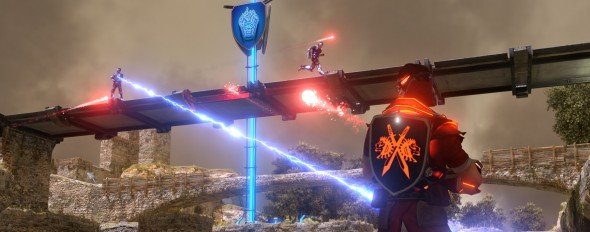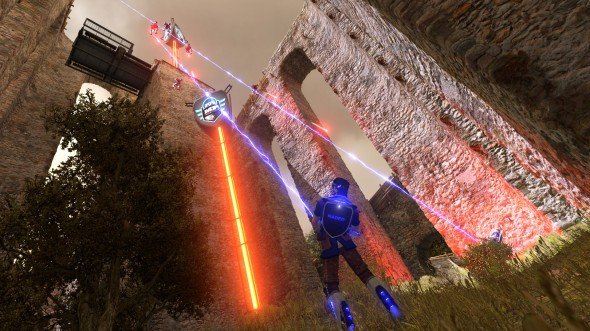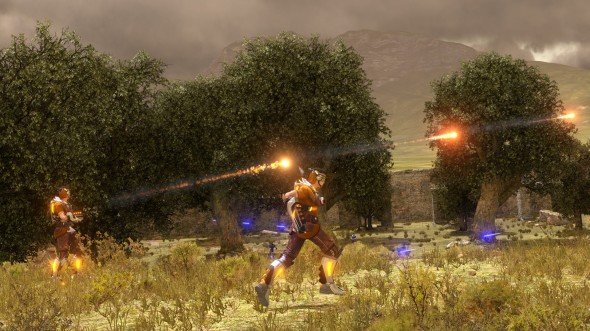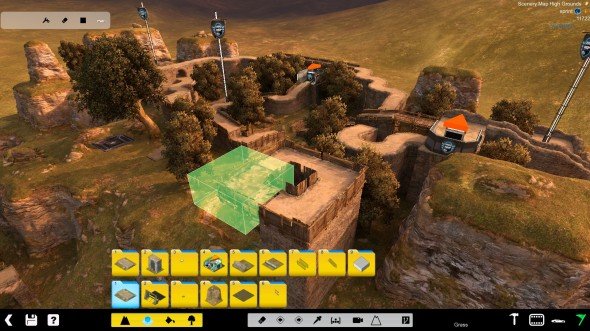Getting to grips with ShootMania Storm

Getting your head around what Nadeo are trying to do with ShootMania is no easy thing. It's a shooter, built by its players, that runs alongside a racing game and will someday share server space with an online RPG. Somewhere in a tiny studio in Paris is a plan where all of this makes sense - but for the rest of us, it can be difficult to pick apart exactly what Nadeo are up to. Here, then, is what you need to know about one of the year's strangest and most interesting projects.
What is it?
ShootMania is TrackMania's multiplayer FPS sibling, and part of the growing ManiaPlanet service. Like TrackMania, it strips its genre down to the bare essentials: in this case, moving and shooting. A deep suite of creation tools allows almost every other aspect of the experience to be generated by the community, to the extent that no-one - not us, not Nadeo - knows ultimately what will be popular and what ShootMania will mean to its fans.
So what do you actually do?
You run around and you shoot people and you try to win. When the game is released, it'll come with around seventeen modes created by Nadeo, ranging from Battlefield-style capture points to team deathmatch and one-on-one duelling. These are only serving suggestions, however, to get players started.
A few game elements are hard-coded. These include weapons: by default, you fire rocket-like energy blasts which regenerate over time. One hit removes an opponent's shields, and another eliminates them (though this can be altered - one game mode, for example, might add successful hits to your score but prevent you from actually eliminating foes.) Other weapons are tied to specific areas of the map. Standing on a futuristic energy plate might grant you a one-shot-kill sniper weapon, while standing on a medieval-style wooden barricade turns you into an arrow-spewing bowman. Again, all of this is for the players to customise.

'Energy blasts'? Where are my guns?
The biggest gaming news, reviews and hardware deals
Keep up to date with the most important stories and the best deals, as picked by the PC Gamer team.
Gone. ShootMania is about as violent as laser quest, without the scrapes and bruises and broken friendships. Nadeo's Florent Castelnérac regards violence as a limit to what a game can achieve as an e-sport. Counter-Strike and Call of Duty make for decent spectator sports within the games community, which is used to regarding terrorism and real warfare as harmless videogame tropes - but a broader audience might not be so comfortable with them. By toning down the viscera in favour of something more family-friendly, they're hoping to find a bigger audience for competitive gaming.
Wait a minute. How do you make an e-sport out of a game without any fixed rules?
Nadeo have focused on creating a core game from which individual spectator sports can be made. There's a major emphasis on visual feedback: the two hit kill system is easy to keep track of at a glance, with shields visibly dissipating on the first strike. Projectile weapons were chosen over hit-scan guns because they allow for exciting near-misses that an audience can appreciate. Players can display team or sponsor logos on their backs, and on the holographic symbols that rise over captured objectives. All of this, according to Castelnérac, is in response to input from the professional e-sports community.
A few default game modes have been designed with competitive play in mind. One is Elite - three on one matches where one player is armed with the one-hit kill laser and the other three rely on rockets. Only points scored as the lone gunman count, and the others need to hunt him down to take his place. Elite is intended to reliably produce the kind of tension usually reserved for rare scenarios in other games, such as one-man-versus-the-world comebacks in Counter-Strike.

Advanced creators will be able to link servers together - spectators could gather on one map to watch matches taking place on other servers on giant in-game screens. Long matches could even take place across several servers, with players transitioning from one to the other on the fly.
How does the editor work?
All of the ManiaPlanet games share an engine, so ShootMania's editor resembles TrackMania's - it's a straightforward grid-based toolset where maps can be altered and played on the fly without loading screens. It's supported by a deep scripting system, which was intended to allow players to create their own modes but has since found use as an all-purpose coding language. Thanks to the community, it's possible to play a full game of Tetris overlaid on normal gameplay.
Creations are shared through storefronts which are loaded in ManiaPlanet's browser-style interface. These are also created by players, who additionally have access to a Twitter-style messaging system, calendars, and in-game blogging.

What are Planets?
In-game currency that is used to buy skins, tracks, maps, game-modes, and even to rent servers. Every player receives a 'salary' of Planets daily, and an additional batch once a month. Otherwise, they're earned from participating in player-run tournaments, selling your creations, and through daily lotteries and scratch-cards within the ManiaPlanet interface.
They have no real-world value, and you can't pay to get more. Castelnérac says that this is essential for Planets to retain their status as “fun money”, without which the culture of sharing that ManiaPlanet relies on would fall apart.
So what do you pay for?
The base game, which will cost €19.99 in Europe. It may also be possible for prolific creators to rent 'shelf space' on servers from which to sell more of their creations, but Nadeo haven't committed to this yet. They're relying on sales of the game alone to support the service. Prioritising the community over microtransactions is a bold move, and one that hopefully will work out for them - if it does, it could influence the way other online game developers approach their players for the better.
What do we think?
It's an incredibly simple game, even to the point of being reductive - but so is Minecraft, and it'd be a mistake to dismiss it on those grounds. By focusing on creating tools rather than prescribed experiences, Nadeo are leveraging the most consistently impressive creative force in gaming at the moment: gamers. If it captures the community's imagination, it could become something very special indeed, and one of the year's surprise hits.
Joining in 2011, Chris made his start with PC Gamer turning beautiful trees into magazines, first as a writer and later as deputy editor. Once PCG's reluctant MMO champion , his discovery of Dota 2 in 2012 led him to much darker, stranger places. In 2015, Chris became the editor of PC Gamer Pro, overseeing our online coverage of competitive gaming and esports. He left in 2017, and can be now found making games and recording the Crate & Crowbar podcast.


